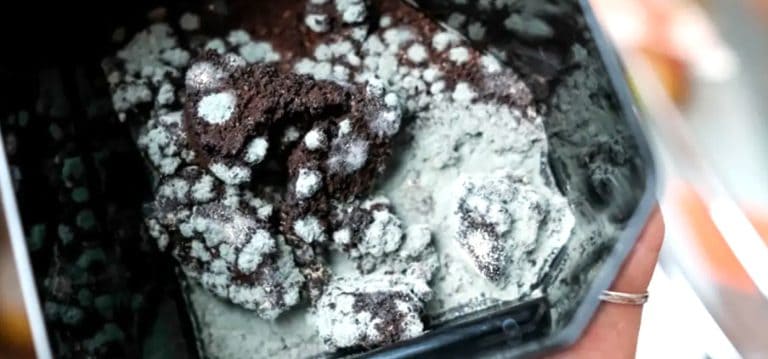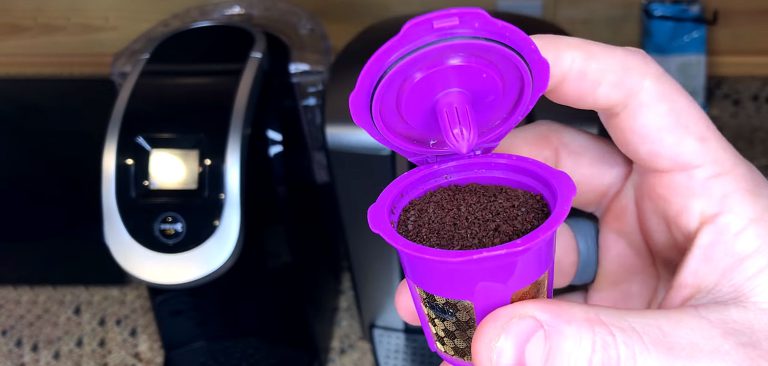Chemex vs Coffee Pods (Nespresso & Keurig) – An Expert’s View
Are you torn between the classic elegance of a Chemex and the convenience offered by coffee pod machines (like Nespresso or Keurig)?
These two methods have gained immense popularity thanks to their own distinct features and the high-quality coffee they brew.
But which one would be better in your kitchen?
In this article, I’ll discuss the advantages and drawbacks of each brewer across different important factors so after reading through, you’ll be able to discern which method suits your taste buds and lifestyle best.
Comparing Chemex & Coffee Pods
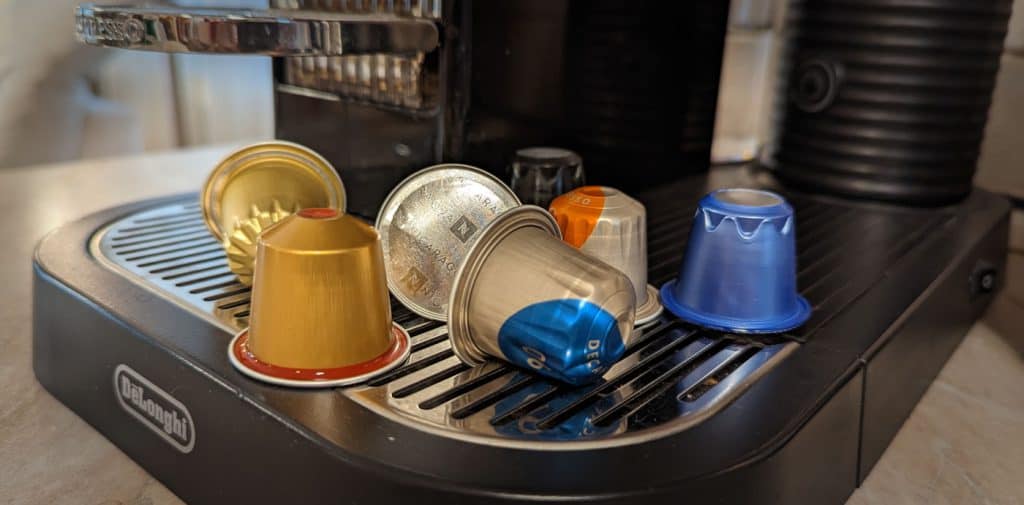

The Chemex is a classic pour-over brewer invented in the 1940s, that produces a robust, clean-tasting cup of coffee. The brewing process involves placing your preferred filter into the top compartment, adding ground beans, and slowly pouring hot water over them in circular motion. The Chemex’s unique construction, paired with the right beans, grind size, and your pouring skills, allow for precise manipulation of the brew, ensuring optimal flavor extraction every time.
Coffee pods are the most popular choice for those seeking convenience without compromising taste. These pre-packaged single-serving capsules fit right into popular pod machines like Nespresso and Keurig K-Cups and you’ll get consistently high-quality coffee. Once the pod is inserted into the machine, it punctures the pod and pushes hot water through it to extract flavorful coffee goodness.
Here are the factors to consider when picking between the two brewing methods, followed by a detailed comparison of each feature:
| Features | Chemex | Coffee Pods |
|---|---|---|
| Taste & Flavor | Unique, clean, light body | Delicious flavors, full aroma |
| Strength | Medium | Varies (mild to extra-strong) |
| Ease of Use | Slight learning curve | Very easy, automated process |
| Brewing Speed | 5-7 minutes | Around 1 minute |
| Versatility | Highly customizable | Limited control over brewing |
| Durability & Portability | Heat-resistant glass, delicate | Durable, but less portable |
| Sustainability | Eco-friendly, reusable | Generates waste, less sustainable |
| Cost | Affordable upfront and long-term | Expensive upfront, costly pods |
Taste, Flavor, & Strength
First, let’s take a look at the taste and strength of both coffees. Chemex has its own unique flavor profile by using a thicker filter, which gives it a clean and light body with just a hint of sweetness that is quite unlike any other brewing method out there.
Chemex coffee has medium-strength intensity, perfect for those who seek a balanced brew that’s not too strong nor too weak.
Meanwhile, coffee pods deliver a balanced intensity with delicious flavors and full aroma which makes every cup of coffee truly satisfying. Nespresso makes espresso shots, while Keurig makes longer black coffee, with only some of their machines being able to make espresso.
Depending on the pod, strength can vary from mild to extra-strong while flavors-wise, each pod can offer a slightly different tasting experience.
This category is really subjective since both can make delicious coffee, so it really depends on which brew your taste likes better. As for me, I like both methods but with the Chemex, I could really fix the coffee that suits my preference which is why I prefer this brewer over the other.
Ease of Use
How easy is it to make coffee with each brewer? Each has its own take on making coffee.
The Chemex requires a slight learning curve with its pouring technique and grinding your own beans with a burr grinder, but overall it isn’t too difficult to get started. Pop in a filter and place medium-coarse ground coffee before pouring hot water at 200°F with a gooseneck kettle. You also need a reliable scale for Chemex (like these), so you can see exactly how much water you poured onto the coffee grinds.
You can follow my simple brewing guide using a Chemex to make the perfect coffee with this brewer.

In contrast, using a coffee pod machine couldn’t be any simpler as all factors, from the ground coffee beans to the water temperature, are taken care of automatically by the device. All you have to do is pop in the capsule into the machine, press a button, and wait for your coffee.
So in terms of simplicity of use,the obvious choice is a coffee pod machine, which is easier to use than Chemex and most brewing methods.
Brewing Speed
For those of us who are always in a rush in the morning, that extra minute or two to make coffee could mean a lot. With Chemex, you’re looking at around 5 to 7 minutes from grinding your beans to brewing and cleaning up afterward.
On the bright side, cleaning your Chemex isn’t overly complicated – provided that you’ll be extra careful when handling the glass vessel. A quick rinse with mild dish soap and hot water should do the trick. Don’t forget to descale it occasionally with the addition of vinegar as a cleaning agent.
In comparison, a coffee pod machine makes coffee fast, taking just a total of one minute since there’s no grinding required, and as an added bonus, cleanup couldn’t be easier either: once brewed, just dispose of the used capsule and wipe down any mess. Like any coffee maker, it also requires a descaling every once in a while.
So if convenience is high on your priority list when making coffee, then coffee pods are perfect for you. But this doesn’t come without a huge compromise, which I’ll discuss later in this article.
Versatility
When brewing, versatility is crucial because it allows us to adjust the brewing process according to our preferences and needs.
For maximum control over the extraction process, I recommend using the Chemex. You can fine-tune everything from grind size to water temperature to pouring rate, allowing you to create a customized cup of coffee that suits your tastes perfectly.
Another advantage of using Chemex is its flexibility in terms of size which comes in four choices:
- 3-cup (16 oz)
- 6-cup (30 oz)
- 8-cup (40 oz)
- 10-cup (50 oz)
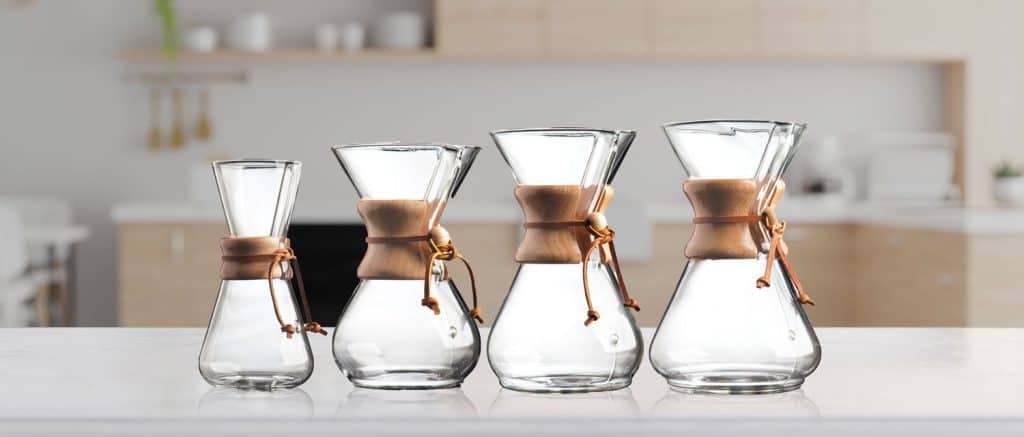
On the other hand, coffee pods offer limited control over the brewing process since most of it is automated. With both Keurig and Nespresso machines, you can only control the cup size, leaving little room for customization. The cup sizes are pretty limited too, often offering only three choices:
- 25 ml
- 40 ml
- 110 ml
Keurig machines can make much larger batches of coffee, from 4 oz to 12 oz.
But mind you, coffee capsules have a fixed amount of coffee in them, so if you choose a larger volume, your coffee will be watered down, and if you choose a smaller size, it will be stronger.
Durability and Portability
Regarding durability and portability, the Chemex and coffee pods are two very different brewing devices. The Chemex is made of heat-resistant, shatterproof glass that can withstand thermal shock, but is still delicate due to its glass body. It could last for a million years in theory, but in reality, an accident will probably chip or crack it sooner or later.
As for coffee pod machines, they are usually quite durable depending on the brand and materials used such as stainless steel and plastic, but being consumer electric devices, they will last a few years at max.
Considering portability though, coffee pod machines tend to be bigger than manual brewers like the Chemex. That being said, I don’t recommend bringing either of the two outdoors, but you can take a smallish coffee capsule machine on a vacation if you know you’ll have a kitchen counter.
Sustainability
It’s important to consider sustainability in brewing since coffee isn’t just about consuming an excellent beverage but also contributing positively to our planet.
The Chemex system is undoubtedly eco-friendly, with its wooden collar and all-glass construction that’s reusable. From cutting back on electricity usage to generating less waste, it ticks almost every box. To top it off, using compostable paper filters makes this method even more sustainable. You can also opt for reusable metal and cloth filters if you like.
Here is more info on the types of Chemex filters you can get.
Coffee pods, while offering a convenient means of making coffee, flunks the sustainability test. The excessive use of non-recyclable pods generates tons of waste globally, causing potential harm to animal life and ecosystems. Although there are options like capsule refill systems, washing and refilling them yourself loses the convenience aspect.
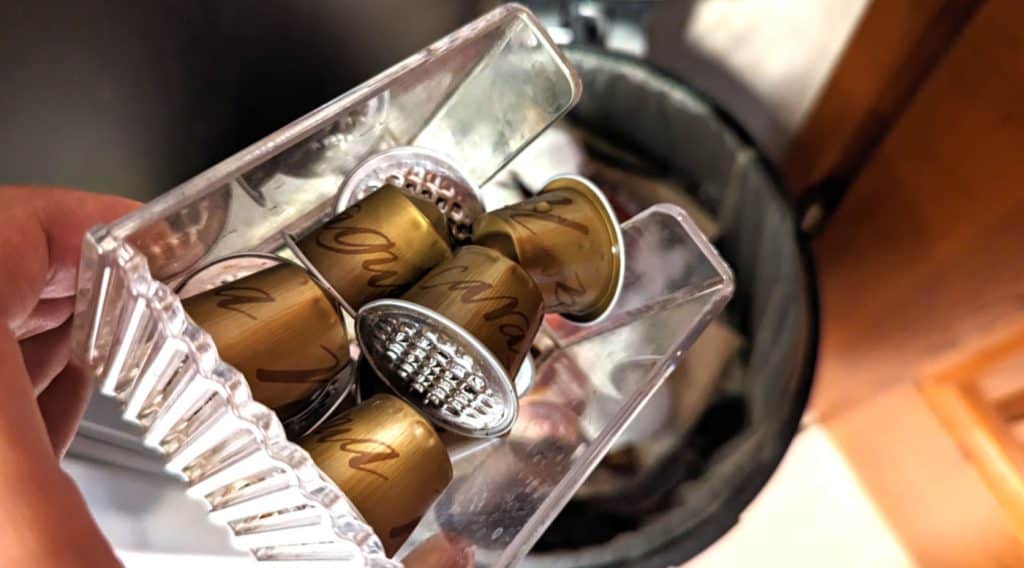
If you value the impact of your daily cup of joe on the planet, then you should go for the Chemex because coffee pod machines can make the most waste compared to other brewing methods out there.
Cost
Another compromise with coffee pod machines is the cost. A Chemex coffee maker will only set you back between $40 to $60 depending on size and where you purchase it from, with a long-term expenditure for Chemex filters at $0.16 per piece in 2025.
This is highly affordable in comparison to coffee pod machines which are generally expensive. They have higher initial investments ranging from roughly $150 to $600 and even then, individual pods are expensive as well. This makes them one of the least cost-efficient options for brewing coffee.
A brand name coffee capsule costs upwards of $0.80, while 15 g of some of the best Chemex coffee beans costs maximum $0.66 at $20/lbs. This is specialty coffee though, so you can downgrade and still drink great coffee at much lower costs than pods.
Chemex and Coffee Pods – Weighing the Pros & Cons
Now that we’ve gotten a closer look at the features of each brewing method, here’s a quick overview of the pros and cons of Chemex and coffee pods so you can finally decide which one is for you:
| Brewing Method | Pros | Cons |
|---|---|---|
| Chemex | – A clean and light cup of coffee – Attractive aesthetic – Offers greater control over the brewing process – A more sustainable brewing method | – The glass design can be fragile – Requires some learning curve – Needs additional effort for cleaning the inside of the carafe |
| Coffee Pods | – Automation allows for quick and convenient brewing – Different kinds of pre-packaged capsules for consistent results | – Requires electricity – Expensive machine and pods – Limited control over the brewing process – Not portable – Pods generate massive waste |
You can also check out my other comparisons between Chemex and these brewing methods:
Here are how other brewers fared against coffee pod machines as well:
Summary
While both brew methods are popular, stylish, and can make good coffee, each has its benefits and drawbacks. The Chemex is versatile and affordable, but requires more time and effort to make, while coffee pod machines are fast and easy to use but have an outsized negative impact on the environment, and are more expensive to use.
In my opinion, the Chemex is the better brewer mainly because it allows me to customize my brew and it doesn’t have to compromise sustainability in the process, unlike coffee pods. If you do prefer convenience, I’d say explore other automatic brewers like a home espresso machine before going straight for the coffee pods.
But that’s just me. How about you, which brewing method suits you better? Let me know in the comments.




